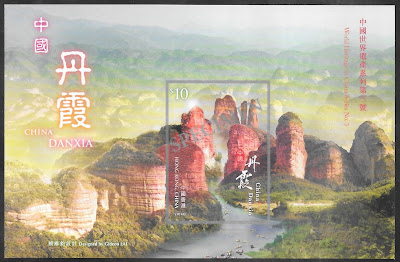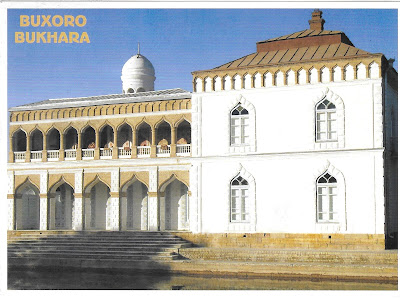where. China
what. stamps (Hong Kong, 2019)
This blog puts together some of my passions: travelling, especially to UNESCO World Heritage Sites (WHS); philately (collecting stamps); deltiology (collecting postcards); and doing research into TUIs (i.e., totally useless information) of things that interest me. Hence, it catalogues UNESCO WHS that I have been to, stamps showing UNESCO WHS that I have, as well as postcards featuring UNESCO WHS that I have received (i.e., stamped and posted) and maxicards and postal cards (both used or unused).
31 December, 2019
23 December, 2019
22 December, 2019
The Great Wall
country. China
year of inscription. 1987
criteria. Cultural
The origins of the Great Wall can be traced to 220BCE, when, under Qin Shi Huang, sections of earlier fortifications were linked to provide a unified defense system against invasions from the north. Construction continued from the 3rd century BCE to 17th century CE, in the Ming Dynasty. With a total length of some 20,000km, it runs from Jiayuguan in Gansu province eastwards to Shanhaiguan in Hebei province, across seven provinces of Gansu, Ningxia, Shaanxi, Shanxi, Hebei, and Liaoning, as well as the two municipalities of Beijing and Tianjin.
21 December, 2019
Xinjiang Tianshan
country. China
year of inscription. 2013
criteria. Natural
The Xinjiang Tianshan WHS comprises of four component sites – Tomur Kalajun-Kuerdening, Bayinbukuke, and Bogda – in the autonomous region of Xinjiang, which are part of the Tianshan mountain system. These areas have unique physical geographic features and scenically beautiful areas of contrasting environments and landscapes. They are also home to endemic and relic flora species, including some rare and endangered ones.
19 December, 2019
Old Town of Lijiang
country. China
year of inscription. 1997 (modification: 2012)
criteria. Cultural
The Old Town of Lijiang WHS is located in the province of Yunnan and is comprised of Dayan Old Town and two village housing clusters to the north: Baisha and Shuhe. Dayan is a historic town founded in the Ming Dynasty (1368CE – 1644CE). The architecture here is reflective of the Naxi people, incorporating elements of Han and Tibetan design motifs. The town also boasts of a complex and ingenuous water-management system, which draws on water and springs on Yulongxueshan (Jade Dragon Snow Mountain) to feed the Heilongtan (Black Dragon Pond) from which water is distributed via a system of canals and channels. Baisha was established earlier during the Song (960CE – 1279CE) and Yuan (1271CE – 1368CE) Dynasties, and is renowned for its religious complex, which contains paintings dating back to the 13th century CE, relating to Buddhism, Taoism, and the Naxi people, with influence with cultural elements of the Bai. Shuhe’s layout reflect a blend of local customs, cultures and traditions.
18 December, 2019
17 December, 2019
Historic City of Ayutthaya
country. Thailand
year of inscription. 1991
criteria. Cultural
The Historic City of Ayutthaya is located in the province of the same name. Founded in 1350, Ayutthaya was the second capital of the Kingdom of Siam. From thence until the 18th century CE, it was a splendid cosmopolitan city, a centre of global diplomacy and trade, characterised by monumental buildings and religious structures. The eclectic Ayutthaya style of architecture and art, which marries the earlier Sukhothai style with foreign influences, continues to be influential in Thailand today. In 1767, the Burmese invaded and razed the city to the ground, expelling all its residents, leaving the site as it is today.
13 December, 2019
Megalithic Jar Sites in Xiengkhuang - Plain of Jars
country. Laos
year of inscription. 2019
criteria. Cultural
The Plain of Jars is an archaeological site of megalithic structures located in Xiengkhuang province. Found here are some 2,100 partially-buried stone jars used for funerary practices sometime between 500BCE and 500CE. The fifteen component sites contain large carved stone jars, stone discs, secondary burial sites, tombstones, quarries, and funerary objects. However, little in known of the civilisation that created these objects.
Vat Phou and Associated Ancient Settlements within the Champasak Cultural Landscape
country. Laos
year of inscription. 2001
year of inscription. 2001
criteria. Cultural
The Champasak cultural landscape, found in Champasak province, includes the Vat Phou Temple complex, two planned cities on the banks of the Mekong River, and Phou Kao mountain. The use of the site for religious purposes date back to the 5th century CE; however, the current structures trace their origins to the Angkor era, from the 11th to the 14th century CE. The temple complex, originally constructed for Shaivite Hindu worship, was part of a planned landscape, comprising of an axis from mountain to river of more than 10km, from which a geometric layout of temples and shrines, settlements, and waterworks were laid out.
Town of Luang Prabang
country. Laos
year of inscription. 1995 (modification: 2013)
criteria. Cultural
The Town of Luang Prabang is located in the province of the same name. Formerly known as Muang Sua, and, later, Xieng Thong, it was the capital of Lan Xang and thence, the centre of Buddhism in the region. Following the establishment of the French Protectorate of Laos in 1893, it once again become the capital, a role it would hold on to until 1946. Today, the town is known for its preserved architectural and artistic heritage, reflecting a fusion of traditional Lao and colonial European styles. This townscape is set against a natural landscape of a peninsula formed from the confluence of the Mekong and Nam Khan Rivers, with sacred Mount Phousi as the backdrop.
Subscribe to:
Posts (Atom)
Grand Canyon National Park
PAGE UNDER CONSTRUCTION country. Japan year of inscription. 2018 criteria. Cultural

-
countries. Austria, Germany, and Slovakia year of inscription. 2021 criteria: Cultural At its zenith, the boundary of the Roman Empire stret...
-
country. Cambodia year of inscription. 2017 criteria. Cultural This WHS, located in the province of Kampong Thom, is the location of Ishanap...
-
country. Japan year of inscription. 2004 (modification: 2016) criteria. Cultural This WHS marks ancient pilgrimage routes and its associated...


























.JPG)